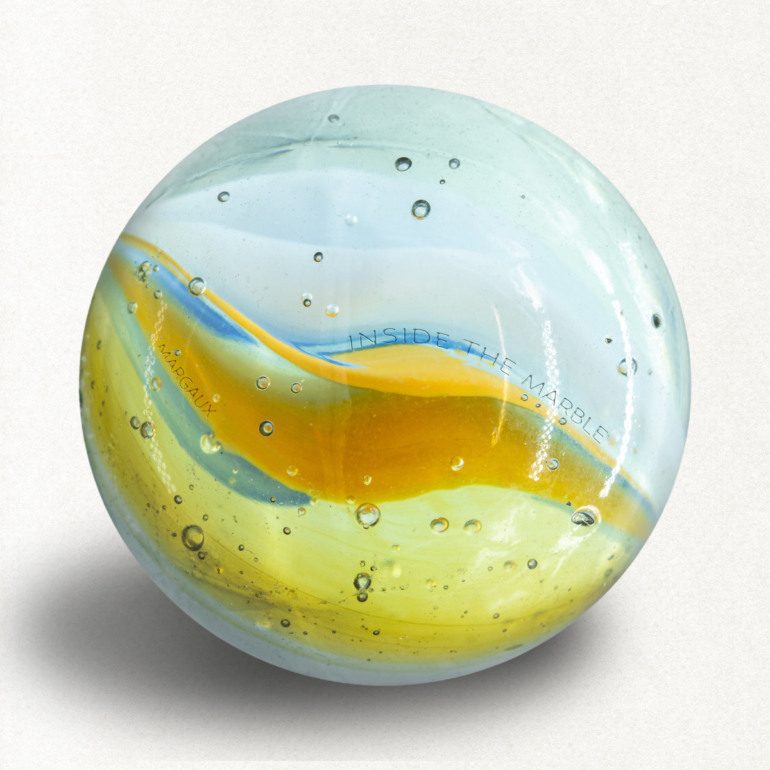

Losing your marbles never sounded more indie
23-year-old Brooklyn-based artist Margaux is “sorting through big feelings,” with her new album Inside the Marble, a journey into the chaoticness of post-graduation and adulthood. After graduating the New School for Social Research, studying jazz before majoring in poetry and non-fiction, the flood of the real world soon arrived at Margaux’s doorstep. Soon, the expressions of turmoil and the confusion of adulthood found a way to hit the strings and bellow into the piano of her small Brooklyn apartment. Welcome Margaux’s first album. A sophisticated five-year project in the making that dives into the naivety of our early 20s and that which comes with it — the ego crushing death of reality, the flood of all possibilities and the eventual downfall of our lives. All mixed in expectations and dreams — a rummaging collision of experimental sounds, ethereal voices, and poetic expression of growth and sadness.
Margaux worked heavily with producer Sahil Ansari, both wanting to push the boundaries of sound and musical tone itself. They began adding in different and exciting instruments, including various strings, synthesizers, and electronic equipment. Even sounds like the violin, clarinet, and trombone can be found throughout the album— syncing back to Margaux’s short stint with a jazz degree at The New School. Specifically working to be different from their previous songs, the prominent electronic layers and drum loops pierced through, finding a way to engineer a new style and fashion altogether. From its long inception, along with Margaux’s growing experience in the music scene, this album centers around what Margaux describes as “novelty,” which in return has resulted in a purely unique sound with musical composition pushing the normal bounds of structure, verse and layering.
Musical variation is key to this album. Songs like “DNA” hit its rock aesthetic with its steady drumbeat and bass, only to follow with “Picture it,” a song made to be soft with heavy reliance on electronic elements. Similarly, songs like “Dissolve/Resolve” stray heavily into metaphors and imagery with lines like, “Photograph of a place I know / Broken glass in between the fold,” while songs like “I Wouldn’t Want it Any Other way” keep the lyrics straightforward and sincere, with lines like, “And when I look at you / I wanna be friends / I wanna be friends with you.” However, diving deeper, the audience can find a similar feeling and tone that transcends the musical differences in composition and style. The tone of self-discovery and otherwise mastery of music and verse is prominent, which in return propelled each track to be in itself a new chapter in an otherwise amazing book of musical excellence. Whether that be Margaux’s continuous ethereal voice, pitching up and often elongating notes to match the distant harmonic sounds, like in her vocal verse in “Ships,” or her beautiful long breathy tones which find ways to perch and then cease throughout the album, it can be said that her style and expression stands the test of time.
Beyond the electronic and experimental sounds, the use of acoustic motifs singularly builds most of the songs throughout the album. Songs like “What Could I Say” and “Midnight Contact” at the end of the album encompasses the guitar, setting it up as the main passenger, delving in and making its picking or slow strums more than half of the song. Similarly, more of the produced and varied songs use the guitar in a new and exciting way — with moments of high-strung claps and stretched-out strings clasping in harsh tones. One of the best examples of this is “I Can’t Decide,” where the small strumming of those stretched strings makes full effect in building an immersive tone.
Lastly, it’s the embodiment of ground-breaking verses that make this album truly different from the normal pop structure. From “Sadie Something” that ends in a surprising rise and climatic combustion of various instruments, along with “Make a Move,” whose outro has a surprising change in tempo and melody. What’s also surprising is “Make a Move”’s amazing use of silence and sound. The absolute and lengthy beautiful sound of the vocalization having its moment in the spotlight before the next sound comes in. Throughout the album, extra verses, surprising solos, defining outros, and even changes in chorus tempo, pattern, melody, and beat bring a new intensity otherwise seen as “too dangerous” to structure.
Whether it be a new instrument creating melodic ways to tell the story or the exploding piano in the chorus of an otherwise silent song, this new album delves into the beauty and mastery of music. While Margaux is hinting at making more of their wonderful music, it is wondrous to take the time to delve into this experimental and fun album that hits on a very common existential dread. Overall, Inside the Marble dives into sound expression in a very fascinating way, building emotions into the stratosphere, only to be returned in a few lines dancing around the three-minute mark.
